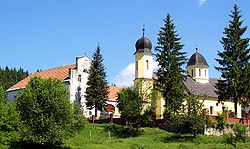
Summary
Gomirje Monastery (Serbian: Манастир Гомирје, romanized: Manastir Gomirje) is a Serbian Orthodox monastery in Croatia. It is the westernmost Serb Orthodox monastery, located in the western part of Croatia near the village of Gomirje, near the town of Ogulin. The monastery is thought to have been founded in 1600. The monastery includes the church of Roždenije saint John the Baptist, built in 1719.
 Gomirje monastery | |
| Monastery information | |
|---|---|
| Full name | Manastir Gomirje Манастир Гомирје |
| Order | Serbian Orthodox |
| Established | 1600 |
| Dedicated to | John the Baptist |
| Diocese | Eparchy of Gornji Karlovac |
| Site | |
| Location | near Gomirje, Croatia |
| Public access | Yes |
History edit
Congregation's and Monastery's early years edit
Gomirje Monastery was built in the period of the first larger Serb settling in the villages of Gomirje, Vrbovsko and Moravice at the end of 16th and the beginning of the 17th century.[1] In 1600 nobleman Juraj Frankopan, brother of the Vuk II Krsto Frankopan, have granted right of "the eternal procuration" of depopulated village of Gomirje to the 325 Serb refugees from Udbina and Korenica which at the time were under the control of the Ottoman Empire.[1] One monk arrived together with settlers and in the 1600-1602 period settlers have build one small wooden chapel for him to serve religious services which will serve as the corner stone of the future monastery.[1] The first conflict with the members of Frankopan family surfaced in the following years when Frankopan's wanted to turn settlers into serfs while settlers claimed rights of the Grenzer or 'Frontiersmen' of the Croatian Military Frontier.[1] In 1602 settlers' mission asked for protection from the Archduke Ferdinand, and in 1608 they asked once again either for protection or resettlement.[1] In 1615 most of the settlers moved away to the Slavonian Military Frontier with only 40 families remaining in Gomirje.[1] In 1621 Vuk II Krsto Frankopan erected one observation tower beside the monastery to control Ottoman movements in the region.[1] In 1617 Gomirje's remaining settlers complained once again through their emissaries in Graz and the entire conflict was not resolved until the year of 1657 when settlers redeemed rights on land of the Gomirje area and defined its boundaries in return for four years of annual fee of 15,000 Forints.[1] 1657 Agreement granted part of the land to the Gomirje Monastery and it was confirmed by the Holy Roman Emperor Leopold I.[1]
As the old monk could not work as the military chaplain settlers invited 6 or 7 new monks from the Krka Monastery who established first wooden Monastery of John the Baptist surrounded with a small property which was increased over the years through purchasing and endowments.[1] At one point Monastery even owned a port in Senjska Draga near the town of Senj.[1] Its monks served in the Gomirje, Vrbovsko, Moravice, Drežnica, Ponikve, Ravna Gora, Jasenak, Tuk, Mrkpolje, as well Marindol and Bojanci in modern-day Slovenia.[1] They served around Žumberak at the times when there was no orthodox priests, but in this they faced resistances from the mid 18th century.[1] In 1719 wooden church was replaced with the one built by stone which was completed in 1730.[1]
Resistance to Uniatism edit
Uniatist efforts of the Roman Catholic Church supported by the authorities intensified in the later part of the second half of the 17th century after decision was taken to transfer seats of eparchies from monasteries to towns.[1] Monks at the Gomirje Monastery provided resistance to the efforts of pro-unitarist bishop Pavle Zoričić resulting in arrests, mistreatment and dungeon sentences.[1] In 1672 group of 14 monks from Gomirje, Marča and Lepavina Monastery were clipped and sentenced to heavy work in shackles as reptiles on galleys or stone carriers in the project of erection of Malta Fortress.[1] In 1750 Gomirje monks were expelled from the Žumberak Mountains.[1] At the time Gomirje resisted unitarist efforts through the activities of the bishop Danilo Jakšić and the generous help in secular and religious books which it received from the Russian Orthodox Church.[1]
1781 Patent of Toleration edit
In 1789, the monastery was devastated by fires and subsequently rebuilt in 1791.[1] In 1810, future metropolitan of Sremski Karlovci, Serbian Patriarch and administrator of Serbian Vojvodina Josif Rajačić became a monk in Gomirje.[1] In 1811, Sava Mrkalj joined the monastic order for two years until he decided to leave Gomirje Monastery in 1813.
20th century edit
During World War I, Austria-Hungary turned Gomirje Monastery into concentration camp for Serbian Orthodox priests from the Triune Kingdom and areas of Vojvodina.[1] The monastery library and collections were professionally organized in 1938 with the expert advice from the Museum of Arts and Crafts, Zagreb.[1] During the World War II, the Ustaše government of the Independent State of Croatia killed monastery monks and took all of the monastery's valuable possessions to Zagreb, while the complex itself was burned in 1943.[1] The monastery was reopened in 1967.[1]
See also edit
References edit
Further reading edit
- Ćirković, Sima (2004). The Serbs. Malden: Blackwell Publishing.
- Mileusnić, Slobodan (1997). Spiritual Genocide: A survey of destroyed, damaged and desecrated churches, monasteries and other church buildings during the war 1991-1995 (1997). Belgrade: Museum of the Serbian Orthodox Church.
- Miller, Nicholas J. (1997). Between Nation and State: Serbian Politics in Croatia Before the First World War. Pittsburgh: University of Pittsburgh Press.
- Вуковић, Сава (1996). Српски јерарси од деветог до двадесетог века (Serbian Hierarchs from the 9th to the 20th Century). Евро, Унирекс, Каленић.
External links edit
- Manastir Gomirje (in Serbian)
45°20′36.07″N 15°6′42.64″E / 45.3433528°N 15.1118444°E


